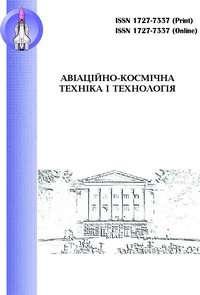Експериментальне дослідження пружних і міцнісних властивостей клеїв

View/
Date
2025Author
Вамболь, О.О.
Гагауз, Ф.М.
Курєннов, С.С.
Барахов, К.П.
Гарбуз, А.О.
Metadata
Show full item recordAbstract
Клейове з’єднання широко застосовується у різних галузях промисловості завдяки своїм унікальним властивостям, надаючи можливість вирішення певних інженерних проблеми, пов'язаних з використанням інших типів з’єднань. Суттєва перевага клейових з’єднань у порівнянні з іншими традиційними мето-дами з'єднання (такими як зварювання, клепання, болтове з’єднання та інші) полягає в їх здатності забезпечувати виготовлення великогабаритних інтегрованих конструкцій. Розробка математичних моделей та аналітичних методів для аналізу міцності та проектування клейових з’єднань мають вирішальне значення для вдосконалення та просування технології клейового з'єднання в інженерну практику. При проектуванні клейових з'єднань для оцінки діючих напружень і визначення потрібної площі з’єднання спираються на відомі пружні та міцнісні характеристики клею. Ці властивості визначають розподіл напружень у клейовому шарі, можливий вид руйнувань та загальну несучу здатність з’єднання. Отже, клейові з’єднання виступають об’єктом дослідження в цій роботі, а предметом дослідження є механічні характеристики клею. Мета роботи полягає в отриманні значень пружних і міцнісних характеристик клеїв, які використовуються при проектуванні з’єднань та служать основними вхідними даними при моделюванні напруженого деформованого стану різних типів клейових з’єднань. В роботі наведено результати експериментального дослідження основних механічних властивостей двох типів клеїв: ВК-9 та 88-НП. У ході експериментальних досліджень отримано модулі зсуву двох клеїв: 361,4 МПа для клею ВК-9 і 16,0 МПа для клею 88-НП. Проведено стандартні випробування для визначення міцності при відриві для двох вибраних клеїв: міцність клею ВК-9 становить 18,17 МПа, для клею 88-НП – 0,19 МПа. В обох випадках визначався характер руйнування клейових з’єднань: тип руйнування зразків, склеєних клеєм ВК-9, переважно відповідав адгезійному руйнуванню, тоді як зразки, склеєні клеєм 88-НП, продемонстрували типовий когезійний і змішаний тип руйнування. Отримані експериментальні дані можуть бути використані як для математичного моделювання напружень у клейових з’єднаннях, так і для розробки та вдосконалення критеріїв руйнування та методів аналізу міцності та проектування клейових з’єднань. Adhesive bonding is widely used across various industrial sectors due to its unique properties, offering effective solutions to certain engineering challenges associated with other types of joints. A significant advantage of adhesive bonding over traditional joining methods (such as welding, riveting, or bolting) is its capacity to facilitate the manufacturing of large-scale integrated structures. The development of mathematical models and analytical methods for analyzing the strength and designing adhesive joints is crucial for improving and advancing adhesive bonding technology in engineering practice. The design of adhesive joints relies on the known elastic and strength properties of the adhesive, which are used to evaluate the acting stresses and to determine the required bonding area. These properties influence the stress distribution within the adhesive layer, the possible type of failure, and the overall loadbearing capacity of the joint. Accordingly, this study focuses on adhesive joints, with particular attention to the mechanical characteristics of the adhesive material. The work aims to determine the elastic and strength properties of adhesives used in the design, serving as the primary input data for modelling the stress-strain state of various types of adhesive joints. The paper presents the results of an experimental investigation into the key mechanical properties of two adhesives: VK-9 and 88-NP. In the course of the experimental studies, the shear moduli of two adhesives were obtained: 361.4 MPa for VK-9 adhesive and 16.0 MPa for 88-NP adhesive. Standard tests were also conducted to determine the peel strength for the two selected adhesives: the strength of VK-9 adhesive is 18.17 MPa, and for 88-NP adhesive it is 0.19 MPa. In both cases, the nature of the failure of the adhesive joints was determined: the failure type of the samples glued with VK-9 adhesive preferably corresponded to adhesive failure, while the samples glued with 88-NP adhesive demonstrated a typical cohesive and mixed failure type. The experimental data obtained can be used both for mathematical modelling of stress distribution in adhesive joints and for the development and refinement of failure criteria, strength analysis methods, and design approaches for adhesive joints.
